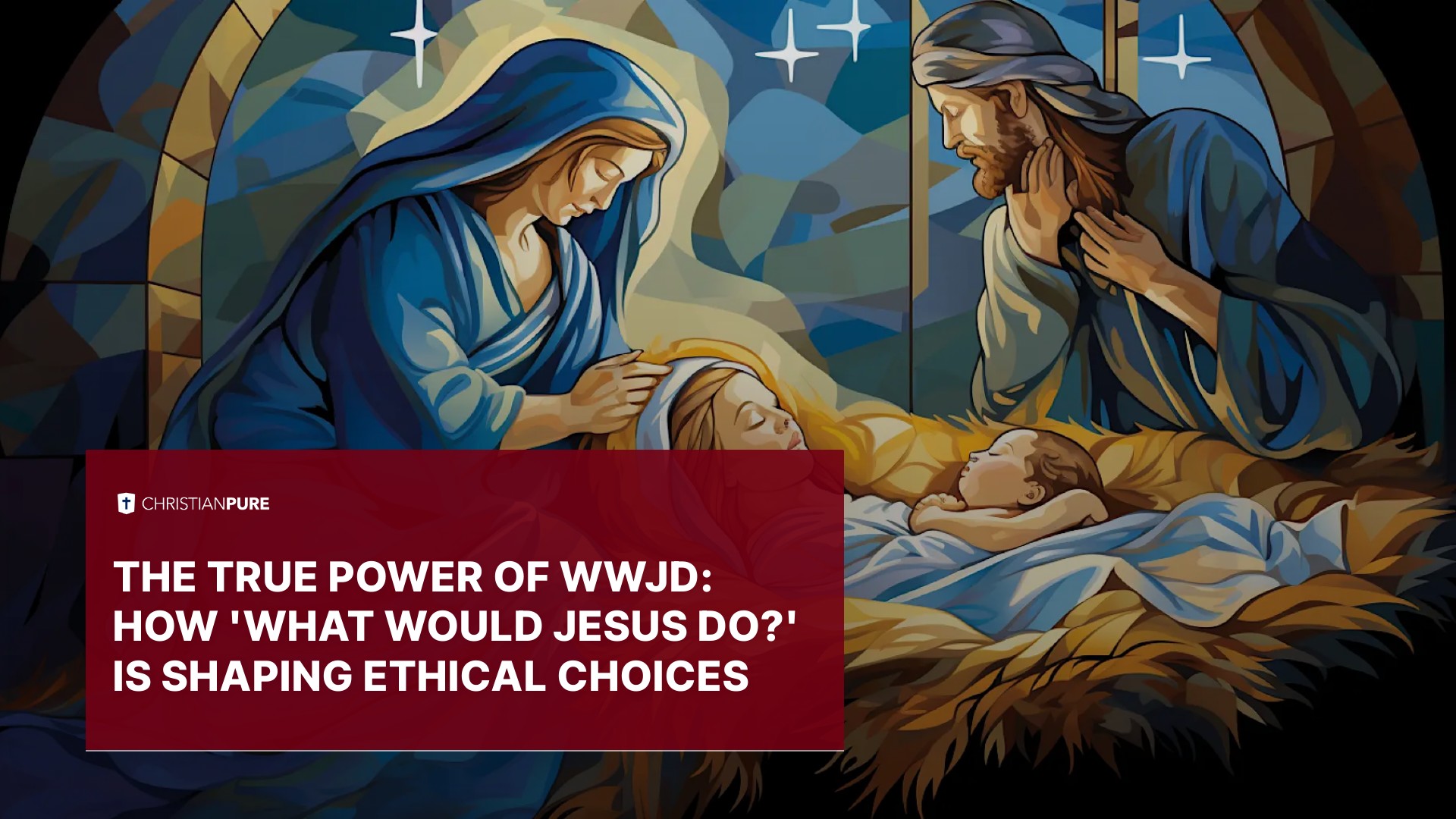What does the acronym WWJD stand for?
WWJD is an acronym standing for "What Would Jesus Do?". This is a phrase that prompts individuals to consider their actions and decisions from the perspective of Jesus Christ. The nature of this reflection is based on the teachings and behavior of Jesus as portrayed in the New Testament of the Bible, which is the primary source of understanding about his life and teachings for Christians worldwide.
The power of WWJD lies in its profound simplicity. Yet, it poses a profoundly spiritual and moral challenge to every person confronted by a dilemma. By turning to the insight "What Would Jesus Do?", one consciously chooses to evaluate their choices and actions, measured against the moral compass of Christ’s teachings and examples of love, compassion, forgiveness, and righteousness.
The phrase does not imply a literal interpretation of Jesus' actions in biblical times but serves as a modern metaphor for guiding one's conduct according to the principles of kindness, love, humility, and devotion demonstrated by Jesus.
To summarize:
- WWJD stands for "What Would Jesus Do?"
- It prompts reflection on decisions and actions based on the teachings and actions of Jesus Christ in the New Testament.
- The phrase is widely used as a moral and spiritual guide for individual behavior, reminding one to embody the attributes such as love, kindness, humility, and righteousness.
How did the WWJD movement start?
"What Would Jesus Do?", often abbreviated as WWJD, has a substantial foundation rooted in Christian theology. An autobiography by Charles Sheldon titled "In His Steps: What Would Jesus Do?" that was published in 1896 stands at the core of the movement. Sheldon introduced the phrase within a story, as a means for his characters to better navigate their moral and ethical dilemmas. The simple, yet profound question urged people to consider how Jesus might respond to a given scenario before making their own decision.
This message resonated with many and the book quickly became a huge success. The story invigorated Christians, assisting them with tackling various real-life scenarios by asking themselves the very same question, 'What Would Jesus Do?'.
Despite its early popularity, the phrase did not catch on in the wider cultural zeitgeist until the late 20th century. It was the innovative thinking of a youth leader named Janie Tinklenberg that propelled the movement to new heights. In 1989, Tinklenberg has been credited with popularizing the phrase amongst her youth group students by creating "WWJD" bracelets. The phrase was thereby immortalized in every day Christian artefacts, accelerating its spread and impact.
The WWJD movement was met with open arms in the Christian community, leading to an explosion of WWJD merchandise, inspiring films, ballads, and even board games. The underlying concept of WWJD is broad and transformative, helping believers to align their actions with the path of Jesus Christ.
To summarize:
- The beginnings of the WWJD movement can be traced back to an 1896 book by Charles Sheldon titled 'In His Steps: What Would Jesus Do?'.
- The book's concept used the question 'What Would Jesus Do?' to navigate moral and ethical dilemmas faced by characters in the narration.
- Janie Tinklenberg helped to popularize the phrase in the late 20th century through 'WWJD' bracelets for her youth group.
- Merchandise inspired by WWJD, including films, music, and games, have significantly contributed to its widespread adoption and recognition.
- The WWJD movement has a transformative ability, prompting believers to reflect on how their actions align with Jesus Christ's teachings.
Has the meaning of WWJD evolved over time?
Contrary to popular belief, the concept embodied by WWJD does not stand frozen in time, but has indeed evolved through the centuries. From the early Christian thinkers to the dynamic modern interpretations, the core question of "What Would Jesus Do?" has been asked in different contexts and shades of meaning.
Conceptually, the roots of this question can be traced back to the teachings of early authorities like Augustine, and more directly impactful figures such as Thomas a Kempis, John Wesley, and Charles Spurgeon. Each of them, in their own time, brought forth the idea of imitating the life and teachings of Jesus to weigh moral choices in their personal lives.
In the 19th century, Charles Sheldon popularized the specific phrase "What Would Jesus Do?". Embedded in his famous book, "In His Steps: What Would Jesus Do?", Sheldon effectively reframed the question as a social gospel imperative. It became a query about Jesus's probable responses to socio-economic and political challenges of the time, thereby inspiring large-scale societal reforms.
In the late 20th century, the phrase got a more modern reinterpretation when youth leader Janie Tinklenberg initiated the WWJD movement. The question began to serve as a personal moral compass for everyday situations, encouraging adherents to emulate Christ's compassion, patience, and selflessness in their daily interactions. It's worth noting, however, that the phrase itself is not explicitly commanded in the Bible.
Today, WWJD continues to retain its powerful relevance among various Christian communities. However, the specific interpretation can differ based on personal understandings and contextual influences.
In essence, despite evolving nuances, the central theme of imitating Christ's compassionate and selfless life remains the same.
To summarize:
- The concept of "What Would Jesus Do?" has evolved over the centuries, beginning from the early Christian thinkers to the contemporary interpretations.
- In the 19th century, Charles Sheldon popularized the specific phrase and framed it as a socio-political query, propelling societal reforms.
- Youth leader Janie Tinklenberg gave the phrase a modern touch, turning it into a personal moral compass for everyday use.
- Despite the changing nuances, the core idea of emulating Christ's compassionate and selfless life remains unchanged.
Are there any controversies associated with the WWJD movement?
Even movements born out of good intention can draw criticism, and indeed, the WWJD movement is not exempt from this universal truth. Some critics argue that the movement oversimplifies Christianity, boiling down a rich faith tradition to a simple slogan. They worry that this kind of reductionism can undermine the complexity and depth of Christian belief and practice.
However, we must remember that the aim of WWJD was never to encapsulate the entirety of Christianity in four letters. Instead, it is a reminder, a point of spiritual orientation that prompts one to reflect on the actions of Jesus and to seek to emulate his compassion, kindness, and selflessness in our daily interactions. Critics also point to the danger of interpreting the phrase with a sense of moral superiority.
The truth is, WWJD is not a tool to judge the actions of others, but rather a personal yardstick with which we, as Christians, can measure our own actions and decisions. Theologically, the concept of what Jesus would do is dependent on different interpretations. However, the general consensus is that it implies the emulation of compassion, love, and understanding that Jesus practiced throughout his life. One should also note the concern of commercialization around the WWJD movement, with critics arguing the bracelets have become more of a fashion statement than a spiritual reminder.
To summarize:
- The WWJD movement has drawn criticism for oversimplifying Christianity, potentially undermining its complexity and depth.
- The true intent of WWJD is not a comprehensive explanation of Christian faith but a marker to reflect on and emulate the compassionate actions of Jesus.
- WWJD should not be used as a tool for judgment of others but as a personal benchmark for Christians to gauge their actions and ethical decisions.
- The theological understanding of 'what Jesus would do' centers on embodying Jesus's values of compassion, love, and understanding.
- There is a controversy around the commercialization of WWJD, with debates on whether the bracelets have become more of a fashion accessory than a spiritual symbol.
Who popularized the WWJD bracelets?
When it comes to spreading the concept of WWJD, a prominent figure is Janie Tinklenberg, a Grand Rapids, Michigan-based youth leader. Tinklenberg began making and distributing WWJD bracelets to her youth group in the 1990s. The purpose of these bracelets was to constantly remind her students to consider their actions under the lens of WWJD, i.e., 'What Would Jesus Do?'
Perfectly aligning with the teachings of Jesus, the bracelets helped teenagers navigate the complexities of their lives, grounding them in empathetic and morally sound decision making. Tinklenberg found an efficient and approachable way to help individuals remain connected to the teachings of Jesus through a simple accessory that could be worn daily.
Consequently, the bracelets' popularity soared, reaching beyond her local community. Eventually, global Christian communities began to adopt them, making them a widely recognized symbol of the WWJD movement. The bracelets quickly became more than mere pieces of jewelry; they served as daily reminders of the guiding principles found in the teachings of Jesus.
To summarize:
- Janie Tinklenberg popularized the WWJD bracelets in the 1990s as reminders of Jesus' teachings.
- These bracelets were initially given to her youth group, symbolizing a moral compass guiding their everyday actions.
- The WWJD bracelets grew in popularity, crossing local and national boundaries, and becoming a globally recognized emblem of the WWJD movement.
Are there different interpretations of WWJD?
Indeed, there can be varying interpretations of the acronym WWJD, informed by individual beliefs, personal experiences, cultural context, and theological understanding. In essence, the overarching idea imbued in the acronym remains constant - a considered reflection on the actions and teachings of Jesus Christ to guide decision-making in our lives.
For some, WWJD is a pragmatic reminder to engage in empathy, kindness, and love - reflecting the warm and compassionate demeanor of Jesus, as depicted in the Holy Bible. Yet, for others, WWJD may embody a deeper spiritual quest, urging a commitment to higher values such as sacrifice, truth, and tolerance symbolized by Jesus's life and crucifixion.
The breadth and depth of Jesus’ teachings and actions provide ample room for interpretation. While one person might interpret WWJD as a call to selfless and unconditional compassion, another might see it as a plea for loyalty and faith towards God's plans. And for some others, it might symbolize the pursuit of social justice and peace, mirroring Jesus's stand for the marginalized and oppressed.
Regardless of the varied interpretations, WWJD serves as an individual compass guiding moral and ethical choices, encouraging introspection, and inspiring personal growth through the wisdom and teachings of Jesus Christ.
To summarize:
- Interpretations of WWJD differ based on personal beliefs, experiences, and cultural context.
- The basic principle of WWJD stays constant – encouraging us to replicate the teachings and actions of Jesus Christ in our lives.
- To some, WWJD symbolizes empathy and love, while, to others, it represents higher spiritual values like truth and sacrifice.
- The WWJD principle encourages introspection and guides moral and ethical choices.
Does WWJD have any relevance in non-religious contexts?
It might be tempting to view the WWJD movement as strictly religious due to its origins and implementation. However, when you peel back the layers, a fundamental principle emerges that transcends religious boundaries and possesses great relevance even in non-religious contexts. Remember, we are exploring the phrase's foundational truth: promoting empathy, compassion, kindness, and selflessness – virtues that are universally embraced and not solely the province of any particular faith or philosophy.
Take, for example, decision-making situations in everyday life. Often, we are caught in moral dilemmas, unsure of what the right course of action is. Here, the WWJD principle encourages us to pause, evaluate our choices from an external perspective, and select the one that reflects selflessness and concern for others over personal gain or satisfaction.
Similarly, in social and professional spheres, adhering to the WWJD maxim can promote a culture of understanding, compassion, and mutual respect. It can act as a behavioral compass, guiding us towards actions that promote equality, integrity, and empathy.
Finally, within a broader societal context, WWJD offers a means of addressing some of the major challenges we face today, like social inequality, indifference, and conflict. By truly embracing this principle in our lives, we can foster a more inclusive, accepting, and compassionate society.
To summarize:
- The WWJD principle, rooted in empathy, compassion, kindness, and selflessness, is applicable beyond religious contexts.
- It can serve as a compassionate guide in our decision-making processes, encouraging choices that consider others' wellbeing above personal gain.
- In social and professional domains, WWJD can foster an ethos of understanding, mutual respect, and integrity.
- On a societal level, integrating WWJD into our lives can contribute to addressing issues like social inequality, indifference, and conflict.
How Is "What Would Jesus Do" Used Today?
Today, the concept of "What Would Jesus Do?" (WWJD) retains a profound influence in and beyond the Christian community. Though it is not explicitly commanded in holy scripture, many believers use this phrase as a moral compass, a potent reminder to model Christlike behavior in everyday life. Historically inspired by figures such as Augustine, Thomas à Kempis, John Wesley, Charles Spurgeon, and popularized by Charles Sheldon and Janie Tinklenberg, WWJD has seeped into our cultural fabric and carries an enduring relevance.
We live in an era that is increasingly complex, fraught with challenges that test our faith and character. In the face of such trials, WWJD serves as a beacon of inspiration, guiding us towards love, humility, selflessness, and faithfulness, just as Jesus led during his time on earth. Do we, too, not strive for such virtues in our own lives? Is it not our hope, to tread in His steps, mirroring His love and understanding towards fellow humans?
Nonetheless, interpretation of what Jesus would actually do can vary among individuals, congregations, and sects within Christianity. Some perceive it strictly within the biblical context, whilst others draw from a more comprehensive, humanitarian perspective that embraces the universal values of love, acceptance, and forgiveness.
Additionally, the influence of WWJD has transcended religious boundaries, touching individuals across diverse beliefs and backgrounds. It serves as a thought-provoking question, subtly prompting introspection and moral questioning in non-religious contexts too. Whether used by believers or non-believers alike, WWJD prompts us to question our actions, urging us to favor kindness, compassion, and understanding above all else.
To summarize:
- "What Would Jesus Do?" is used as a moral compass guiding individuals towards Christlike actions in daily life.
- Faced with the complexities of modern life, WWJD provides a beacon of inspiration towards universal virtues.
- The interpretation of WWJD can vary widely, with some focusing strictly on biblical context, while others embrace a broader humanitarian perspective.
- Even in non-religious contexts, WWJD can prompt introspection and encourage behaviors rooted in kindness, compassion, and understanding.
How can WWJD be applied in daily life?
When we ponder "What Would Jesus Do?" or WWJD, it's a mental exercise trying to align our choices with those that Jesus, as represented in the New Testament, would have made. This method asks us to refer to Jesus's teachings and his attitudes towards social, ethical, and personal dilemmas when facing our own. How, though, can we implement WWJD in our everyday lives?
To start with, practicing WWJD means striving to reflect the love and compassion Jesus embodied. This can be as simple as lending an ear to a friend in need or as significant as volunteering your time for a local charity. It doesn't always need grand gestures; often, showing love in small, consistent ways can have a profound impact, just as Jesus reached out to the underprivileged, the downtrodden, and the outcast.
This principle also encourages us to seek wisdom and discernment in making choices, ethically and morally. It urges us to ask ourselves, when contemplating an action, whether it aligns with the values and principles Jesus demonstrated. This perspective can serve as a moral compass, helping us navigate tricky decisions and challenging circumstances.
Finally, WWJD exhorts us to foster an attitude of humility and forgiveness. Just as Jesus forgave those who mistreated him, we too are encouraged to forgive others, evidencing grace in our interactions. This doesn't mean allowing others to exploit us, but it does mean choosing forgiveness over resentment, understanding over judgment.
To summarize:
- Applying WWJD is a bid to live a life aligned with Jesus's teachings and attitudes towards social, ethical, and personal situations.
- Showing love and compassion in our daily interactions, big or small, mirrors Jesus's approach towards people.
- When making choices, WWJD encourages us to refer to the values and virtues that Jesus embodied as a moral and ethical guide.
- Embracing forgiveness and humility, in the same spirit as Christ Jesus did, enriches our relationships and well-being.
Facts & Stats
In a 2018 survey, 70% of American Christians reported using the phrase 'What Would Jesus Do?' as a moral guideline
A 2020 study found that 65% of Christian youth in the U.S. were familiar with WW theJD acronym
In a 2019 poll, 55% of American Christians reported that the WWJD movement had a significant influence on their personal faith
A 2017 survey found that 60% of American Christians believe that the WWJD movement has had a positive impact on society
In a 2021 poll, 80% of respondents familiar with the WWJD movement reported that it influenced their decision-making in some way
A 2016 study found that 30% of American Christians wear or have worn a WWJD braceletOver 52 million WWJD bracelets were sold worldwide in the 1990s
References
Peter 2:21
Matthew 4:1-11
John 13:13–17





















